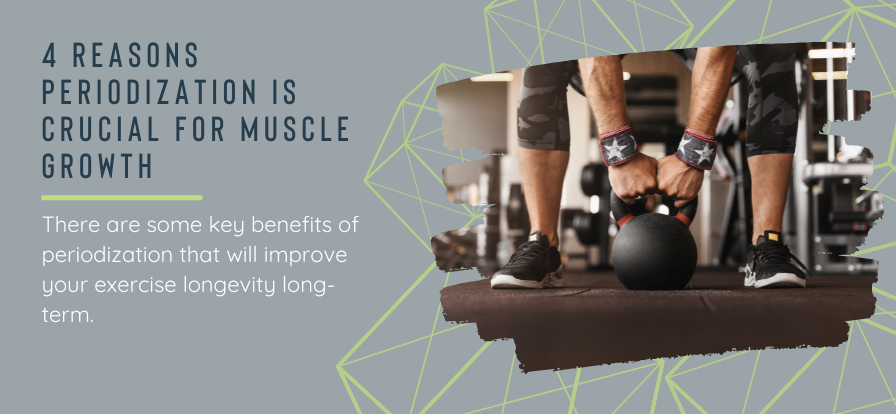4 Reasons Periodization is Crucial for Muscle Growth
Written by Martin Ebner, Head PT and sports nutrition coach at Ebylife
Are you eager to achieve your goals for muscle growth but find yourself running into roadblocks because you lack focus and strategy? If you want to pack on lean muscle while staying healthy and balanced, then periodization should be a key part of your strength training routine.
Periodization is the act of planning your training in specific phases with a defined goal and progressive overload program. This post will cover the basics of periodization and four reasons why it's essential long-term for continued muscle building.
The Basics of Periodization
Periodization has been used by athletes for years to maximize performance and peak at the right time. For example, those who are training for the Olympics are on a four-year training plan! Even if you’re not planning to compete, those interested in building muscle through strength training or bodybuilding can also benefit from periodization.
Periodization refers to the process of breaking down your training into distinct stages or periods. You can make the most efficient use of your time and effort by carefully planning and strategically manipulating training variables, such as reps, sets, and load.
You don't want to be sporadic. Constant change for the sake of change is not the goal. With periodization, you are intentionally and methodically varying your training regimen. It can also help to prevent boredom and break through plateaus.
Some basic periodization models include:
Linear periodization: this is the most basic form of periodization, and involves gradually increasing the volume and intensity of your training over time. This is perfect for beginners.
Non-linear (or undulating) periodization: this approach varies the volume and intensity of your training from one workout to the next; this is a more advanced technique.
Conjugate (or block) periodization: this is a most advanced form of periodization that involves training different aspects of your fitness (e.g., strength, power, and endurance) in distinct blocks or phases. Ideal for athletes.
Other terminology frequently used to discuss periodization timelines includes:
Macrocycles: the longest training cycles and usually last several months to a year.
Mesocycles: shorter cycles that last anywhere from a few weeks to a few months and focus on a specific goal like muscle growth, strength, or power.
Microcycles: the shortest training cycles, lasting a couple of weeks or less.
Why Periodization is Important for Muscle Growth
While scientific research hasn't decisively concluded that periodization is superior for muscle growth compared to other strength training plans, there are some key benefits that will improve your exercise longevity long-term. Here are four of the big ones.
1. Periodization increases load gradually and is ideal for novice exercisers
Periodization involves gradually increasing the load (or intensity) of your workouts over time. If you're new to weightlifting or strength training, this gradual progression is ideal because it will help you master the form and technique of new movements while changing just one variable of intensity at a time.
This allows your body to adapt to the new demands, making you stronger and less prone to injuries whilst helping you gain muscle each month.
If you're just starting out, try a linear periodization model in which you gradually increase the load (weight) lifted each week. So, for your current mesocycle, if you can squat 100 pounds for eight reps, add 5 pounds every 2-3 weeks as you feel comfortable while maintaining the same number of reps and sets.
2. Periodization helps you avoid overtraining and plateaus.
Overtraining is a common issue among exercisers, especially those who are determined to bulk up and hit the gym most days of the week. When you overtrain, your body doesn't have time to recover and adapt between workouts, which can lead to fatigue, injuries, and a decrease in performance.
Periodization can help you avoid overtraining by built-in scheduled rest and recovery days into your training plan. For example, within a microcycle, you focus on rest between sets within the workouts and rest days throughout the week. Within mesocycles and macrocycles, rest occurs in the form of tapering or recovery weeks.
Check out this visual for an aerobic and strength training periodization program. The grey blocks represent reducing periods of reducing the load in order to learn new exercises and prepare for a more vigorous challenge.
3. Periodization can help to prevent boredom
Periodization may be a good solution if you're someone who quickly gets bored with their workout routine. Instead of monotonous workouts with no end in sight, periodization lays out goals and milestones for you to work towards.
Seeing your progress clearly charted out can help to maintain enthusiasm and give your workout purpose.
On another note, you may be limited in the types of exercises you can do either because of equipment you have available or physical limitations. Even if you're restricted to basic moves, applying periodization principles will help you progress over time as you take on more weight, complete a higher volume of repetitions, and increase your overall training volume. This definitely helps keep things more interesting!
4. Periodization helps you break through plateaus and progress strategically
Are you working out regularly, but progress seems to be at a standstill? If you work out for any length of time, you'll probably find yourself facing this predicament: the dreaded plateau.
Plateaus are normal, but that doesn't make them any less frustrating. Fortunately, the strategic nature of periodization can help you break out of a training rut. By constantly changing your workouts and giving your body new challenges to adapt to, you'll eventually find the right combination of intensity, volume, and exercises to help you move forward again.
Conclusion
When it comes to working out, there's no one-size-fits-all approach. Some people thrive on spontaneity, while others prefer a more structured approach. If you're the latter, periodization may be the perfect workout method.
Not only does periodization help to avoid overtraining and injury, but it can also help keep you motivated and see progress over time. So to keep yourself progressing, be sure to talk to your trainer about a periodization program for you. We’ve also created a great 12-week workout program for those looking to pack on some serious muscle.
The Ultimate 3-day Bulk-up Workout Plan
Welcome to the ultimate 3-day Full-body bulk-up workout plan for skinny guys.
What’s included in the plan:
✔ A fully comprehensive 3-day workout plan (To be repeated for 8-12 weeks or until you reach your ideal weight and/or results).
✔ 3 Full-body workouts designed for maximum muscle growth (hypertrophy). You will be hitting all of the major muscle groups every workout with a selection of compound and isolation exercises.
✔ A daily sample from our Bulk-up meal plan for skinny guys.
✔ A delicious post-workout smoothie recipe to support your gains.
✔ This workout plan combines perfectly with all of our Bulk-up diet plans (Omnivore, vegetarian, and vegan) for skinny guys.
While this plan is suited for all fitness levels, it’s ideal for men with 12 months or less of strength training experience.
The file is in PDF format and is compatible with all phones, computers, and tablets.





